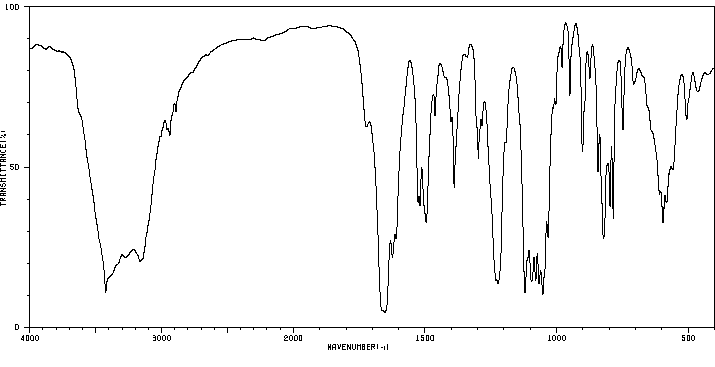胞苷 2ˊ,3ˊ-环一磷酸钠盐 | 15718-51-1
分子结构分类
中文名称
胞苷 2ˊ,3ˊ-环一磷酸钠盐
中文别名
胞苷2ˊ,3ˊ-环一磷酸钠盐;环胞苷酸;胞苷2′:3′-环一磷酸单钠盐
英文名称
cytidine 2′,3′-cyclic monophosphate sodium salt
英文别名
sodium;1-[(3aR,4R,6R,6aR)-2-hydroxy-6-(hydroxymethyl)-2-oxo-3a,4,6,6a-tetrahydrofuro[3,4-d][1,3,2]dioxaphosphol-4-yl]-4-iminopyrimidin-2-olate
CAS
15718-51-1
化学式
C9H11N3O7P*Na
mdl
——
分子量
327.166
InChiKey
SQOIXCJUYWSZDW-IAIGYFSYSA-M
BEILSTEIN
——
EINECS
——
-
物化性质
-
计算性质
-
ADMET
-
安全信息
-
SDS
-
制备方法与用途
-
上下游信息
-
文献信息
-
表征谱图
-
同类化合物
-
相关功能分类
-
相关结构分类
物化性质
-
熔点:>209°C (dec.)
-
溶解度:可溶于DMSO(轻微加热)、甲醇(轻微)、水(轻微)
计算性质
-
辛醇/水分配系数(LogP):-5.03
-
重原子数:21
-
可旋转键数:2
-
环数:3.0
-
sp3杂化的碳原子比例:0.56
-
拓扑面积:147
-
氢给体数:2
-
氢受体数:7
安全信息
-
危险品标志:Xn
-
危险类别码:R26
-
WGK Germany:3
-
安全说明:S20/21/22,S36/37/38
-
储存条件:20°C
SDS
反应信息
-
作为反应物:描述:[Ru2Cl2(N,N′‑diphenylformamidinate)3] 、 胞苷 2ˊ,3ˊ-环一磷酸钠盐 以 甲醇 为溶剂, 反应 25.0h, 以64%的产率得到[Ru2Cl(N,N′‑diphenylformamidinate)3(cytidine-2′,3′-cyclic monophosphate monoanion)]参考文献:名称:胞嘧啶,腺嘌呤及其衍生物对开桨式二钌化合物的配位能力摘要:[Ru 2 Cl 2(DPhF)3 ](DPhF =二苯基甲酰胺酸酯)优先连接到RNA(核糖核酸)结构的连接处,尽管键的模式尚不清楚。为了阐明这个问题,[Ru 2 Cl 2(DPhF)3]和胞嘧啶(Hcyto),胞苷(Hcyti),胞苷2',3'-环一磷酸钠(NacCMP),腺嘌呤(Hade),腺苷(Haden)和腺苷3',5'-环一磷酸(HcAMP)进行了。在所得的复合物中,细胞(胞嘧啶),胞嘧啶(胞嘧啶),cCMP(胞苷2',3'-环一磷酸单阴离子),ade(腺苷),aden(腺苷酸)和cAMP(去质子化腺苷3',5'-环状单磷酸)作为N,N '桥键配体键合到二钌单元上,如[RuCl(DPhF)3(细胞)]和[RuCl(DPhF)3的晶体结构的溶液所证实(ade)]通过X射线衍射。钌物种的轴向位置仍可用于与其他残基的其他相互作用,这可能解释了其对RNA连接的偏好。DOI:10.1016/j.jinorgbio.2018.06.010
-
作为产物:参考文献:名称:Phosphorylation, oligomerization and self-assembly in water under potential prebiotic conditions摘要:在水的环境下对(前)生物底物进行磷酸化,是生命起源中的关键一步。以往的研究要么成功率有限,要么需要特殊环境,这些环境与后续产生相应寡聚体或更高层次结构不相容。在这里,我们证明了二氨基磷酸盐(DAP)——一种可能的前生物剂,由三聚磷酸盐产生——在不需要缩合剂的情况下,能够有效地在水溶性(溶液/膏状)条件下,对多种(前)生物构建单元(核苷/酸、氨基酸和脂质前体)进行(氨基)磷酸化。值得注意的是,更高层次的结构(寡核苷酸、肽和脂质体)在相同的磷酸化反应条件下形成。这种可能的前生物磷酸化过程在类似的反应条件下,可以在单一的水环境中实现三种(前)生物相关分子的系统化学及其寡聚体。在水中对(前)生物分子进行磷酸化一直是前生物化学长期追求的目标。现在,我们已经证明二氨基磷酸盐在水中对核苷、氨基酸和甘油/脂肪酸进行磷酸化的同时,也在同一反应混合物中形成更高层次的结构,如寡核苷酸、肽和脂质体。DOI:10.1038/nchem.2878
表征谱图
-
氢谱1HNMR
-
质谱MS
-
碳谱13CNMR
-
红外IR
-
拉曼Raman
-
峰位数据
-
峰位匹配
-
表征信息
同类化合物
非阿尿苷5’-单磷酸酯
阿拉伯糖基胸腺嘧啶 5'-三磷酸酯
阿拉伯呋喃糖基尿苷三磷酸酯
锂3'-脱氧-5-乙炔基-5'-O-(羟基膦酸)尿苷
苯甲基4-[(4,5-二氢-3-甲基-5-羰基-1-苯基-1H-吡唑-4-基)偶氮]苯酸酯
苯乙酸,4-(1,1-二甲基-2-丙烯基)--α--甲基-(9CI)
苯(甲)醛,O-(4-硝基苯甲酰)肟
脱氧尿苷 5'-三磷酸酯
胸苷酸二钠
胸苷酸
胸苷二磷酸酯-L-鼠李糖
胸苷-5'-三磷酸
胸苷 3',5'-二磷酸酯
胸腺嘧啶脱氧核苷酸5-单磷酸对硝基苯酯钠盐
胞苷酰-(5'-3')-尿苷酰基-(5'-3')-尿苷
胞苷单磷酸酯-N-羟基乙酰基神经氨酸
胞苷5-(三氢二磷酸酯),化合物与2-氨基乙醇(1:1),单钠盐
胞苷5'-四磷酸酯
胞苷5'-单磷酸甲酯
胞苷-5’-二磷酸
胞苷-5’-三磷酸二钠盐
胞苷-5’-三磷酸二钠盐
胞苷-5'-单磷酸-N-乙酰神经氨酸
胞苷-5'-单磷酸-N-乙酰神经氨酸
胞苷-5'-二磷酸三钠
胞苷 5’-单磷酸
胞苷 3',5'-二磷酸酯
胞苷 2ˊ,3ˊ-环一磷酸钠盐
胞磷胆碱钠
胞磷托定
胞嘧啶-5'-二磷酸二钠
胞二磷胆碱
聚尿苷酸钾盐
聚(5-甲硫基尿苷单磷酸)
羟基甲磺基次酸
羟基甲基脱氧尿苷三磷酸酯
磷酸)二氢2'-脱氧-5-(甲氧基甲基)尿苷5'-(
碘脱氧尿苷酸
甲氨蝶呤5-氨基烯丙基-2'-脱氧尿苷5'-单磷酸酯
生物素-36-脱氧三磷酸胞苷
生物素-36-脱氧三磷酸尿苷
环胞苷 5'-磷酸酯
溴脱氧尿苷三磷酸酯
氨基嘧啶酮-4-二磷酸二胺-2-C-甲基-D-赤藓糖醇
尿苷酰基(2'->5')尿苷铵盐
尿苷二磷酸酯葡萄糖胺
尿苷二磷酸酯甘露糖
尿苷二磷酸酯半乳糖胺
尿苷二磷酸酯N-乙酰基-D-氨基甘露醇醛酸盐
尿苷二磷酸酯 N-乙酰基甘露糖胺







